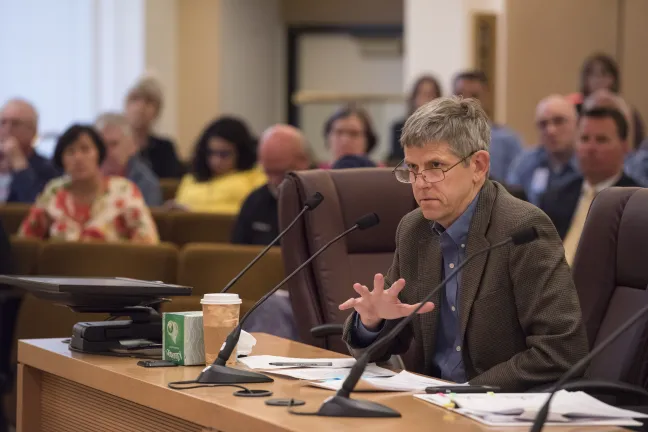The Board of County Commissioners on Thursday approved a new five-year contract with American Medical Response to provide emergency 911 ambulance service beginning Sept. 1, 2018.
The County does not directly operate or subsidize the 911 EMS system, but it is responsible for the ambulance contract and provides medical direction to ensure that all County residents are served.
For that reason, the County maintains a very uniform system across a geographically diverse region, including a single 911 center, operated by the Portland Bureau of Emergency Communications; a single contracted ambulance provider that serves the entire County; and one EMS medical director who directs care standards. Fire departments also respond for the most serious calls.
“We are proud of our EMS system outcomes and our ability to help in the most severe situations,’’ said Dr. Paul Lewis, the Tri-County Health Officer and director of the EMS program.
“For example: Multnomah County cardiac arrest survival in 2016 was twice as high as the national average 16.9% vs 8.4%. Twice!”
In December 2016, the Board approved an updated Multnomah County Ambulance Service Plan. The plan was originally written and approved in 1994. In 2017, the Health Department began a Request for Proposals process and in August, four ambulance providers attended the mandatory pre-proposal meeting.
But when the deadline for bids closed in February 2018, only AMR had submitted a proposal. Lewis said the County put that proposal through a rigorous evaluation by an external panel of EMS administrators, managers and medical directors, as well as an internal health equity expert. Ultimately, the AMR proposal received a high score.
Dr. Lewis told the Board that the new ambulance contract the County has since negotiated with the company has several important improvements over the last contract, including:
- New response time requirements, adding accountability for lower-urgency calls
- New clinical measures of patient outcomes
- An electronic medical record will follow the patient, no matter who picks them up.
- Joint fire and EMS training and supply reimbursement
- New health equity requirements to create a more diverse EMS workforce, provide culturally and linguistically relevant care, and improve EMS access to historically underserved communities
- A simplification of response time sub zones so they’re easier to understand
The contract is also less costly to ratepayers than proposed. AMR initially sought a 60 percent increase from their current rate of $1,008, to more than $1,600 per transport. The Multnomah County EMS Office and rate review committee, however, felt the proposed service didn’t justify an increase of that magnitude. (While Medicaid and Medicare pay a fixed, discounted rate, private insurers such as Blue Cross and Kaiser, and those with no insurance, pay the full rate.)
Lewis said the company agreed instead to a contract rate of $1,350, with an annual increase linked to the consumer price index and limited to a maximum of 5.5 percent. (For context, charges by AMR in Clark and Clackamas counties are $1,157 and $1,212, respectively.)
“Our team had to continuously balance the needs of the residents and our responsibility to address medical cost inflation with the for-profit interests of the private owners of ambulance companies, the regional private ambulance administration, six fire departments, three small cities without fire departments, and labor unions representing both firefighters and ambulance paramedics,’’ Lewis said. “We also needed to complete this effort while operating under substantial Oregon statutes, County code and internal purchasing rules.”
Union representatives protested that the new contract did not include a unit-hour utilization measurement of employee workload to guard against fatigue.
“This has always been a standard in the contract between your current EMS provider and Multnomah County,’’ said Dave Tully, of the International Brotherhood of Teamsters, Local 223. “The County is getting busier, it is getting hard to get around. These people struggle daily to get to these people that you are caring for.’’
But Dr. Lewis said the utilization measurement is a less-sophisticated measure of workload that is not a standard in national contracts. Instead, the new contract requires AMR to use real-time data to monitor the amount of time employees spend on a task, the number of high-priority calls per shift, total miles driven, and the number of shifts per pay period. The contract also requires a 10-hour minimum rest period between shifts and the use of floating pools of employees who can cover extra hours.
Commissioner Loretta Smith proposed an amendment that would have sent the contract back to negotiators to include the measure as a workforce protection, but the amendment failed for lack of a second. An assistant county attorney noted the contract has been fully negotiated for months and that any changes would require a significant negotiation.
“My main concern is making sure that our paramedics are receiving and entitled to the rest breaks and respite they need in between calls,” Commissioner Lori Stegmann said. “I want to make sure the provisions are in the contract, and it sounds like they are. I think what we are really talking about are semantics.”
Commissioner Jessica Vega Pederson said she would feel better if the board could see the progress of the monitoring and the new contract at a public meeting within six months.
With that the Board approved the contract by a 4-1 vote, with Commissioner Smith dissenting.
“It’s clear that patient care and safety are priorities for everyone here, and we have tried to build the mechanics of a contract that meet those goals while keeping our obligation to manage costs for everyone, but especially for those who are not insured,’’ Chair Deborah Kafoury said. “Multnomah County has a long track record of standing up for workers rights and we will continue to monitor and make sure people abide by the values we've set as a County."

